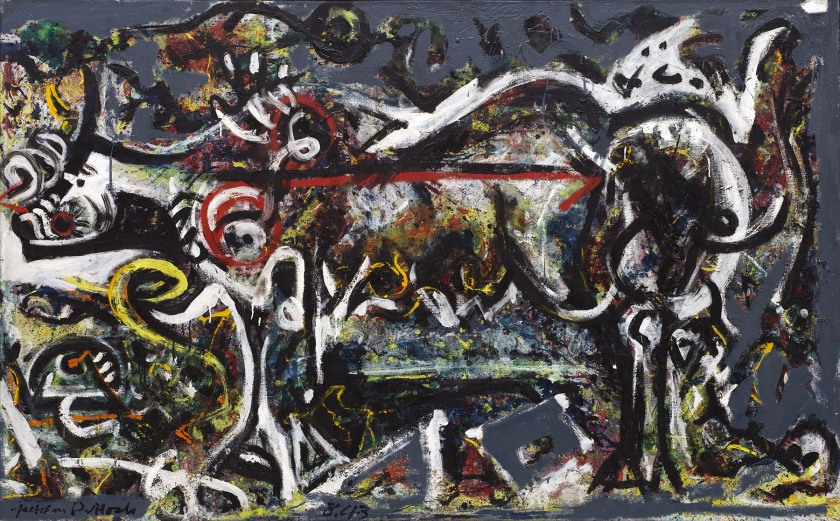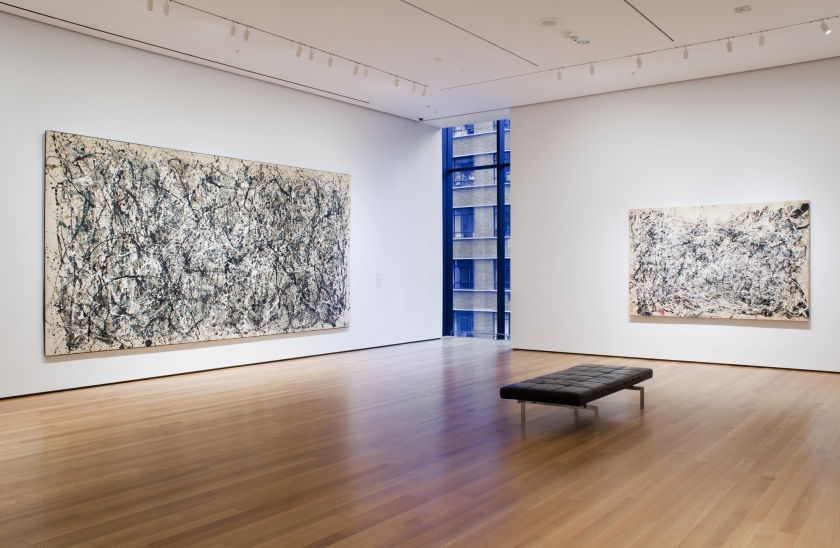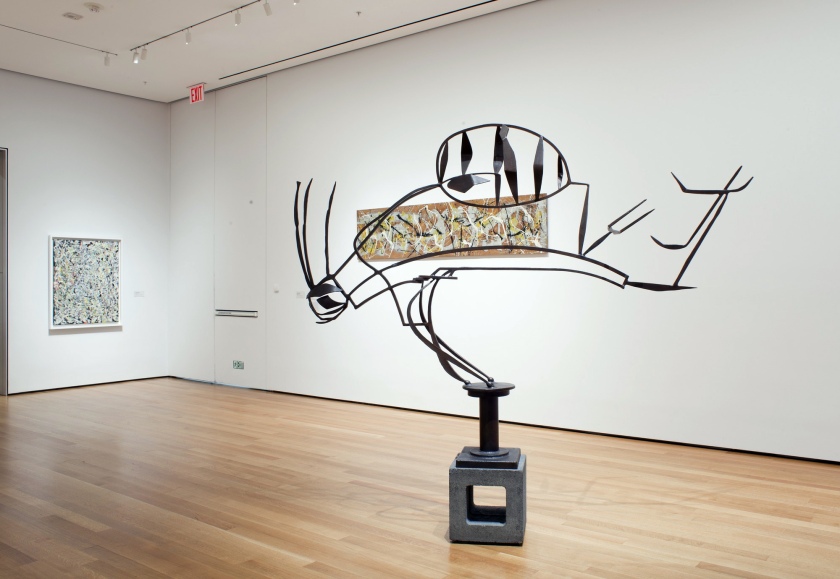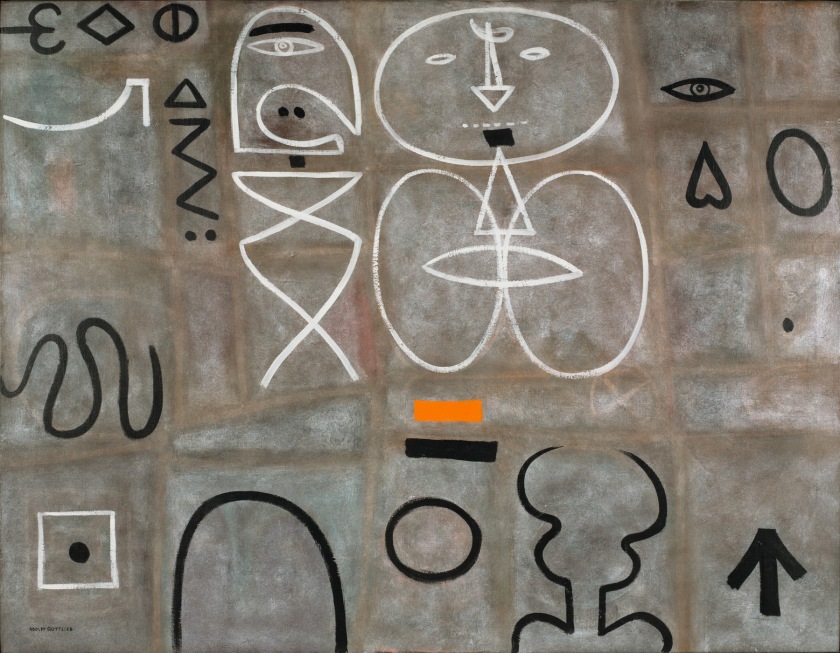Exhibition dates: October 3rd 2010 – April 25th 2011
Mark Rothko (American born Latvia, 1903-1970)
Slow Swirl at the Edge of the Sea
1944
Oil on canvas
6′ 3 3/8″ x 7′ 3/4″ (191.4 x 215.2cm)
Bequest of Mrs. Mark Rothko through The Mark Rothko Foundation, Inc.
© 1998 Kate Rothko Prizel & Christopher Rothko / Artists Rights Society (ARS), New York
Slow Swirl at the Edge of the Sea pictures two creatures dancing between sea and sky, surrounded by arabesques, spirals, and stripes. The forms “have no direct association with any particular visible experience, but in them one recognises the principle and passion of organisms,” Rothko said. For him art was “an adventure into an unknown world”; like the Surrealists before him, Rothko looked inward, to his own unconscious mind, for inspiration and material for his work.
Gallery label from Abstract Expressionist New York, October 3, 2010 – April 25, 2011
What a privilege to post all of these works together.
Aaron Siskind has to be one of my favourite photographers of all time (and space). His Martha’s Vineyard (see photograph below), like most of his work, is superb: the abstraction and counterpose are magnificent. Team this with a couple of Rothko, a Motherwell, a de Kooning and a knockout of a Hartigan and you certainly have the start of ‘The Big Picture’. I wish I could have been there to see this exhibition – sigh!
Marcus
.
Many thankx to The Museum of Modern Art for allowing me to publish the photographs in the posting. Please click on the photographs for a larger version of the image.
Installation view of the exhibition, Abstract Expressionist New York: Rock Paper Scissors at MoMA, New York October 3, 2010 – February 28, 2011
Photograph by Thomas Griesel
Jackson Pollock (American, 1912-1956)
The She-Wolf
1943
Oil, gouache, and plaster on canvas
41 7/8 x 67″ (106.4 x 170.2cm)
Purchase
© 2010 The Pollock-Krasner Foundation / Artists Rights Society (ARS), New York
In the early 1940s Pollock, like many of his peers, explored primeval or mythological themes in his work. The wolf in this painting may allude to the animal that suckled the twin founders of Rome, Romulus and Remus, in the myth of the city’s birth. But “She-Wolf came into existence because I had to paint it,” Pollock said in 1944. In an attitude typical of his generation, he added, “Any attempt on my part to say something about it, to attempt explanation of the inexplicable, could only destroy it.” The She-Wolf was featured in Pollock’s first solo exhibition, at Art of This Century gallery in New York in 1943. MoMA acquired the painting the following year, making it the first work by Pollock to enter a museum collection.
Gallery label from Abstract Expressionist New York, October 3, 2010 – April 25, 2011
Installation view of the exhibition, Abstract Expressionist New York: Rock Paper Scissors at MoMA, New York October 3, 2010 – February 28, 2011 showing at right, Jackson Pollock’s painting Number 1A, 1948
Photograph by Thomas Griesel
Jackson Pollock (American, 1912-1956)
Number 1A, 1948
1948
Oil and enamel paint on canvas
68″ x 8′ 8″ (172.7 x 264.2cm)
Purchase
© 2010 The Pollock-Krasner Foundation / Artists Rights Society (ARS), New York
While the style of “drip” painting has become synonymous with the name Jackson Pollock, here the artist has autographed the work even more directly, with several handprints found at the composition’s upper right. Around this time Pollock stopped giving his paintings evocative titles and began instead to number them. His wife, artist Lee Krasner, later explained, “Numbers are neutral. They make people look at a painting for what it is – pure painting.” Collectors did not immediately appreciate Pollock’s radical new style, and when first exhibited, in 1949 (then titled Number 1, 1948), this painting remained unsold. Later that year the work was shown again in the artist’s second solo exhibition (Pollock added “A” to the title to avoid confusion with more recent work) and shortly thereafter was purchased by MoMA.
Gallery label from Abstract Expressionist New York, October 3, 2010 – April 25, 2011
Bradley Walker Tomlin (American, 1899-1953)
Number 20
1949
Oil on canvas
7′ 2″ x 6′ 8 1/4″ (218.5 x 203.9cm)
Gift of Philip Johnson
Although some of the ribbons and bars that animate Number 20 are recognisable letters of the alphabet (E, X, or Z) these and their more abstract neighbours evoke calligraphy without constituting it. A critic described these symbols as “hieroglyphs that lack only the appropriate Rosetta Stone for their deciphering.” Tomlin distributed his nonobjective imagery evenly on the canvas, depriving the work of a traditional focal point and creating a staccato rhythm and allover design that invites the viewer’s glance to travel across its surface.
Gallery label from Abstract Expressionist New York, October 3, 2010 – April 25, 2011
Installation view of the exhibition, Abstract Expressionist New York: Rock Paper Scissors at MoMA, New York October 3, 2010 – February 28, 2011 showing at left, Barnett Newman’s painting Vir Heroicus Sublimis (1950-51)
Photograph by Thomas Griesel
Barnett Newman (American, 1905-1970)
Vir Heroicus Sublimis
1950-51
Oil on canvas
7′ 11 3/8″ x 17′ 9 1/4″ (242.2 x 541.7cm)
Gift of Mr. and Mrs. Ben Heller
© 2019 Barnett Newman Foundation / Artists Rights Society (ARS), New York
Vir Heroicus Sublimis, Newman’s largest painting at the time of its completion, is meant to overwhelm the senses. Viewers may be inclined to step back from it to see it all at once, but Newman instructed precisely the opposite. When the painting was first exhibited, in 1951 at the Betty Parsons Gallery in New York, Newman tacked to the wall a notice that read, “There is a tendency to look at large pictures from a distance. The large pictures in this exhibition are intended to be seen from a short distance.” Newman believed deeply in the spiritual potential of abstract art. The Latin title of this painting means “Man, heroic and sublime.”
Gallery label from Abstract Expressionist New York, October 3, 2010 – April 25, 2011
Jack Tworkov (American born Poland, 1900-1982)
West 23rd
1963
Oil on canvas
60″ x 6′ 8″ (152.6 x 203.3cm)
The Museum of Modern Art, New York. Purchase
© Estate of Jack Tworkov, courtesy Mitchell-Innes & Nash, New York
Robert Motherwell (American, 1915-1991)
Elegy to the Spanish Republic, 54
1957-1961
Oil on canvas
70″ x 7′ 6 1/4″ (178 x 229cm)
The Museum of Modern Art, New York. Given anonymously
© Dedalus Foundation, Inc./Licensed by VAGA, New York, NY
Installation view of the exhibition, Abstract Expressionist New York: Rock Paper Scissors at MoMA, New York October 3, 2010 – February 28, 2011 showing at left, David Smith’s sculpture Australia (1951)
Photograph by Thomas Griesel
David Smith (American, 1906-1965)
Australia
1951
Painted steel
6′ 7 1/2″ x 8′ 11 7/8″ x 16 1/8″ (202 x 274 x 41cm), on cinder block base, 17 1/2 x 16 3/4 x 15 1/4″ (44.5 x 42.5 x 38.7cm)
The Museum of Modern Art, New York. Gift of William Rubin
© Estate of David Smith/Licensed by VAGA, New York, NY
At the time of its completion, Australia was Smith’s largest sculpture. By welding together thin rods and plates of steel he created a work that is simultaneously delicate and strong, a masterpiece of tension, balance, and form that he described as a “drawing in space.” Sculpture has traditionally been defined by volume and mass; Australia is, in contrast, built of lines. In what might be described as an allover sculpture, the linear activity is greatest at the perimeters, while the center is nearly empty. Because of its title, the work is sometimes read as an abstracted kangaroo, its lines capturing the spring of the animal’s leap.
Gallery label from Abstract Expressionist New York, October 3, 2010 – April 25, 2011
Installation view of the exhibition, Abstract Expressionist New York: Rock Paper Scissors at MoMA, New York October 3, 2010 – February 28, 2011 showing a wall of photographs by Aaron Siskind, including at second right, Martha’s Vineyard (1954-1959)
Photograph by Thomas Griesel
Aaron Siskind (American, 1903-1991)
Martha’s Vineyard
1954-1959
Gelatin silver print
12 7/16 x 16 1/2″ (31.6 x 41.9cm)
The Museum of Modern Art, New York. Purchase
© 2010 Estate of Aaron Siskind
Adolph Gottlieb (American, 1903-1974)
Man Looking at Woman
1949
Oil on canvas
42 x 54″ (106.6 x 137.1cm)
Gift of the artist
© Adolph and Esther Gottlieb Foundation/Licensed by VAGA, New York, NY
In the 1940s Gottlieb began to emulate the art of early Native American and Middle Eastern cultures, explorations that eventually inspired his Pictograph paintings, including Man Looking at Woman. This work and others like it feature hieroglyphic-like script distributed across the canvas in a series of gridded compartments. Gottlieb avoided using decipherable signs. In 1955 he said of these works, “I frequently hear the question, ‘What do these images mean?’ That is simply the wrong question. Visual images do not have to conform to either verbal thinking or optical facts. A better question would be: ‘Do these images convey any emotional truth?'”
Gallery label from Abstract Expressionist New York, October 3, 2010 – April 25, 2011
Arshile Gorky (American born Armenia, 1904-1948)
Agony
1947
Oil on canvas
40 x 50 1/2″ (101.6 x 128.3cm)
The Museum of Modern Art, New York. A. Conger Goodyear Fund
© 2010 The Arshile Gorky Foundation / The Artists Rights Society (ARS), New York
The evocative title of this work and the fiery intensity of the palette signal a departure from Gorky’s more lyrical abstractions of the preceding years. Agony, a blazing, impassioned scene, is often understood in relation to the traumatic events of the artist’s personal life, including a fire in his studio and cancer.
Gallery label from Abstract Expressionist New York, October 3, 2010 – April 25, 2011
Subtitled The Big Picture, this installation of 100 Abstract Expressionist paintings and a rich selection of some 60 sculptures, drawings, prints, and photographs, occupies the entire fourth floor of the Museum and chronicles the era of Abstract Expressionism. The movement drew together a host of artists with greatly varying stylistic approaches, but with a common commitment to the power of an abstract art that could express personal convictions and profound human values.
Organised in a loose chronology, intermittently interrupted by monographic galleries that allow for the in-depth study of an individual artist’s practice, the installation opens with a selection of paintings and drawings that attest to the acutely self-conscious sense of new beginnings present in the work of individuals such as Jackson Pollock and Mark Rothko. In the immediate aftermath of World War II, they and their peers – not yet a cohesive group – created imagery that evoked primitive man or ancient myth, and conjured an aquatic or geological pre-human world.
Upon entering the galleries, visitors are greeted by Jackson Pollock’s The She-Wolf (1943), which was featured in the artist’s first solo exhibition, in 1943, and was the first work by Pollock to enter a museum collection when MoMA acquired it the following year. Made before Pollock developed his signature “drip” style, the canvas shows that a free-form abstraction and an unfettered play of materials were already parts of his process. Also on view is Mark Rothko’s Slow Swirl at the Edge of the Sea (1944), a canvas picturing two creatures floating between sea and sky, surrounded by arabesques, spirals, and stripes that betrays the influence of Surrealism on Rothko’s early work.
A monographic gallery devoted to the work of Barnett Newman includes Onement, I (1952), which the artist later identified as his breakthrough painting. Modest in size, it consists of a monochromatic background divided in half by a vertical band, or “zip” as the artist later called it. Every successive painting by Newman, as seen in the seven works in this gallery, features this particular compositional motif, although their formal and emotional differences are apparent. The scale and proportions of the paintings, as well as their palette and brushwork, vary from work to work, as do the number of zips and their location in the field of colour. At the other end of the spectrum from this relatively small canvas is Vir Heroicus Sublimis (1950-1951), an 18-foot-wide, vibrant red expanse that was Newman’s largest painting at the time of its creation.
The distinctive materials, techniques, and approaches developed and practiced by the Abstract Expressionists can be seen in a number of other works from the late 1940s and early 1950s. For Painting (1948), Willem de Kooning used oil and enamel sign paint to create a densely packed painting in which the paint drips, bleeds, congeals, or dissolves into delicate streaks. Lee Krasner’s Untitled (1949) shows that she applied thick paint – sometimes directly from the tube – in rhythmic and repetitive strokes, giving equal attention to every inch of the canvas and creating an allover composition. Bradley Walker Tomlin, in Number 20 (1949), and Adolph Gottlieb, in Man Looking at Woman (1949), distributed imagery evoking the alphabet and hieroglyphics evenly across their canvases.
A large gallery focusing on the work of Jackson Pollock includes Full Fathom Five (1947), one of earliest “drip” paintings, and Number 1A, 1948 (1948), the first drip painting to enter MoMA’s collection (in 1950). For One: Number 31, 1950 (1950), a masterpiece of the drip technique and one of Pollock’s largest paintings (8′ 10″ x 17′ 5 5/8″ (269.5 x 530.8 cm)), the artist laid the canvas on the floor of his studio and poured, dribbled, and flicked enamel paint onto the surface, sometimes straight from the can, or with sticks and stiffened brushes. The density of interlacing liquid threads of paint is balanced and offset by puddles of muted colours and by allover spattering.
Eight paintings made by Mark Rothko over a 14-year period are presented in a single gallery. The earliest examples from 1948, such as No. 1 (Untitled), feature variously sized abstract forms caught mid-motion as they shift on the canvas. Beginning in 1950, Rothko’s “classic” style forms as the artist creates a composition from horizontal planes of thinly layered paint and highly modulated colour, simplifying the compositional structure of his paintings and arriving at his signature style. No. 10 (1950) is divided horizontally into three dominant planes of blue, yellow, and white that softly and subtly bleed into one another. Acquired by MoMA in 1952, it was the first Rothko to enter the Museum’s collection, and was considered so radical that a trustee of the Museum resigned in protest.
MoMA’s practice of making in-depth acquisitions of work by artists that its curators judged to be of greatest importance was complemented by acquisitions of smaller numbers of works by other artist who played roles too significant to be forgotten. The Big Picture includes paintings and sculptures by more than 20 artists.
There is a gallery devoted to a selection of photographs made by individuals who used a camera to explore kindred artistic concerns – often resulting in work with striking stylistic similarities. Aaron Siskind may be the photographer most closely associated with Abstract Expressionism, and numerous works of his on display suggest the depth of this connection. Also featured in this installation is work by Harry Callahan, Robert Frank, Minor White, and others, revealing the variety of ways in which the sensibility or structure of paintings from this period manifested itself photographically.
The exhibition includes some 30 items from the MoMA Archives, documenting the relation of the Museum to Abstract Expressionism. Materials represent the institution’s influential series of “Americans” exhibitions, organised by Dorothy C. Miller, which included several Abstract Expressionist artists in four of its iterations. In addition, documentation regarding the internationally circulating New American Painting show (also organised by Miller) is presented. This important exhibition travelled to eight European cities in 1958-59 and propelled the homegrown Abstract Expressionist movement onto the international art scene. A third section includes photographs of artists and their own statements and letters. Highlights include: exhibition catalogues, installation photographs, news clippings, and ephemera; photographs of artists in the studio with their artworks; a letter from Robert Motherwell to Miller describing the four themes of his art (automatic means, pure abstractions, political or a kind of “disasters” series, and intimate pictures), a letter from Ad Reinhardt to Miller recommending a different installation of his paintings, and a statement by Grace Hartigan identifying her subject as the “vulgar and vital in American life, and the possibilities of its transcendence into the beautiful.”
Text from the Museum of Modern Art press release
Installation view of the exhibition, Abstract Expressionist New York: Rock Paper Scissors at MoMA, New York October 3, 2010 – February 28, 2011 showing a wall of the photographs of Robert Frank (Swiss-American, 1924-2019)
Photograph by Thomas Griesel
Robert Frank (Swiss-American, 1924-2019)
Paris
1952
Gelatin silver print
Robert Frank (Swiss-American, 1924-2019)
Mississippi, St Louis
1948
Gelatin silver print
Robert Frank (Swiss-American, 1924-2019)
New York
c. 1949
Gelatin silver print
Ibram Lassaw (American born Egypt, 1913-2003)
Kwannon
1952
Welded bronze
6′ 1/2″ x 43″ x 29″ (184.2 x 109.2 x 73.7cm)
The Museum of Modern Art, New York. Katharine Cornell Fund
© 2010 Denise Lassaw/Ibram Lassaw studio
This sculpture represents Kwannon (also known as Kannon), the Buddhist goddess of mercy and an attendant of Buddha. Lassaw thickened steel wire with molten bronze, creating an openwork metal scaffolding of irregular lines and voids – what he called a “drawing in space.” Lassaw wrote of this abstract figure, “Although I never try to depict or narrate or communicate, I feel that something of Kwannon entered this piece of sculpture.”
Gallery label from Abstract Expressionist New York, October 3, 2010 – April 25, 2011
Willem de Kooning (American born The Netherlands, 1904-1997)
Woman, I
1950-1952
Oil on canvas
6′ 3 7/8″ x 58″ (192.7 x 147.3cm)
The Museum of Modern Art, New York. Purchase.
© 2010 The Willem de Kooning Foundation / Artists Rights Society (ARS), New York
De Kooning famously said, “Flesh is the reason oil paint was invented,” and although he often worked in an abstract style he continually returned to the figure. Woman I took an unusually long time to complete. De Kooning made numerous preliminary studies then repainted the canvas repeatedly, eventually arriving at this hulking, wild-eyed figure of a woman. An amalgam of female archetypes, from a Paleolithic fertility goddess to a 1950s pinup girl, her threatening gaze and ferocious grin are heightened by de Kooning’s aggressive brushwork and intensely coloured palette.
Gallery label from Abstract Expressionist New York, October 3, 2010 – April 25, 2011
Grace Hartigan (American, 1922-2008)
Shinnecock Canal
1957
Oil on canvas
7′ 6 1/2″ x 6′ 4″ (229.8 x 193cm)
The Museum of Modern Art, New York. Gift of James Thrall Soby
© 2010 The Estate of Grace Hartigan
Louise Nevelson (American born Ukraine, 1899-1988)
Sky Cathedral
1958
Painted wood
11′ 3 1/2″ x 10′ 1/4″ x 18″ (343.9 x 305.4 x 45.7cm)
The Museum of Modern Art, New York. Gift of Mr. and Mrs. Ben Mildwoff
© 2010 Estate of Louise Nevelson/Artists Rights Society (ARS), New York
Sky Cathedral. 1958 | MODERN ART & IDEAS
Hans Hofmann (American born Germany, 1880-1966)
Memoria in Aeternum
1962
Oil on canvas
7′ x 6′ 1/8″ (213.3 x 183.2cm)
The Museum of Modern Art, New York. Gift of the artist
© 2010 Renate, Hans & Maria Hofmann Trust / Artists Rights Society (ARS), New York
In Memoria in Aeturnum (Eternal memory) Hofmann remembers five American painters who died in their prime: Arthur B. Carles, an early American Cubist, and four abstract painters whose work is on display in this exhibition – Arshile Gorky, Franz Kline, Jackson Pollock, and Bradley Walker Tomlin. Painted near the end of his life, Hofmann’s work is a tribute to the preceding decades of abstract art, incorporating a wide range of techniques that evoke the spirits of the departed: stains, drips, drawn-out brushstrokes, and smooth-edged geometric forms.
Gallery label from Abstract Expressionist New York, October 3, 2010 – April 25, 2011
Installation view of the exhibition, Abstract Expressionist New York: Rock Paper Scissors at MoMA, New York October 3, 2010 – February 28, 2011 showing at right, Mark Rothko’s painting No. 5 / No. 22 (1950)
Photograph by Thomas Griesel
Mark Rothko (American born Latvia, 1903-1970)
No. 5 / No. 22
1950
Oil on canvas
9′ 9″ x 8′ 11 1/8″ (297 x 272cm)
The Museum of Modern Art, New York. Gift of the artist.
© 1998 Kate Rothko Prizel & Christopher Rothko / Artists Rights Society (ARS), New York
Mark Rothko (American born Latvia, 1903-1970)
No. 3 / No. 13
1949
Oil on canvas
7′ 1 3/8″ x 65″ (216.5 x 164.8cm)
The Museum of Modern Art, New York
Bequest of Mrs. Mark Rothko through The Mark Rothko Foundation, Inc.
© 1998 Kate Rothko Prizel & Christopher Rothko / Artists Rights Society (ARS), New York
The Museum of Modern Art
11 West 53rd Street, New York
NY 10019
(212) 708-9400
Opening hours:
Sun – Fri 10.30am – 5.30pm
Sat 10.30am – 7.00pm





























You must be logged in to post a comment.